《数据库系统概念 Database System Concepts》原书教学资源(第五版,PPT课件讲稿,英文版)Chapter 1 Introduction(Avi Silberschatz Henry F. Korth S. Sudarshan)
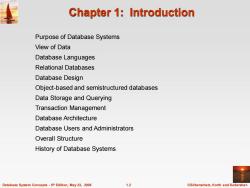
Chapter 1:Introduction Purpose of Database Systems View of Data Database Languages Relational Databases Database Design Object-based and semistructured databases Data Storage and Querying Transaction Management Database Architecture Database Users and Administrators Overall Structure History of Database Systems Database System Concepts-5th Edition,May 23,2005 1.2 @Silberschatz,Korth and Sudarshan
Database System Concepts - 5 1.2 ©Silberschatz, Korth and Sudarshan th Edition, May 23, 2005 Chapter 1: Introduction Purpose of Database Systems View of Data Database Languages Relational Databases Database Design Object-based and semistructured databases Data Storage and Querying Transaction Management Database Architecture Database Users and Administrators Overall Structure History of Database Systems

Database Management System (DBMS) DBMS contains information about a particular enterprise Collection of interrelated data Set of programs to access the data An environment that is both convenient and efficient to use Database Applications: Banking:all transactions Airlines:reservations,schedules Universities:registration,grades Sales:customers,products,purchases Online retailers:order tracking,customized recommendations Manufacturing:production,inventory,orders,supply chain Human resources:employee records,salaries,tax deductions Databases touch all aspects of our lives Database System Concepts-5th Edition,May 23,2005 1.3 ©Silberschat乜,Korth and Sudarshan
Database System Concepts - 5 1.3 ©Silberschatz, Korth and Sudarshan th Edition, May 23, 2005 Database Management System (DBMS) DBMS contains information about a particular enterprise Collection of interrelated data Set of programs to access the data An environment that is both convenient and efficient to use Database Applications: Banking: all transactions Airlines: reservations, schedules Universities: registration, grades Sales: customers, products, purchases Online retailers: order tracking, customized recommendations Manufacturing: production, inventory, orders, supply chain Human resources: employee records, salaries, tax deductions Databases touch all aspects of our lives
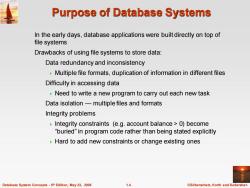
Purpose of Database Systems In the early days,database applications were built directly on top of file systems Drawbacks of using file systems to store data: Data redundancy and inconsistency Multiple file formats,duplication of information in different files Difficulty in accessing data Need to write a new program to carry out each new task Data isolation-multiple files and formats Integrity problems Integrity constraints (e.g.account balance 0)become "buried"in program code rather than being stated explicitly Hard to add new constraints or change existing ones Database System Concepts-5th Edition,May 23,2005 1.4 @Silberschatz,Korth and Sudarshan
Database System Concepts - 5 1.4 ©Silberschatz, Korth and Sudarshan th Edition, May 23, 2005 Purpose of Database Systems In the early days, database applications were built directly on top of file systems Drawbacks of using file systems to store data: Data redundancy and inconsistency Multiple file formats, duplication of information in different files Difficulty in accessing data Need to write a new program to carry out each new task Data isolation — multiple files and formats Integrity problems Integrity constraints (e.g. account balance > 0) become “buried” in program code rather than being stated explicitly Hard to add new constraints or change existing ones

Purpose of Database Systems (Cont.) Drawbacks of using file systems(cont.) Atomicity of updates Failures may leave database in an inconsistent state with partial updates carried out Example:Transfer of funds from one account to another should either complete or not happen at all Concurrent access by multiple users Concurrent accessed needed for performance Uncontrolled concurrent accesses can lead to inconsistencies Example:Two people reading a balance and updating it at the same time Security problems Hard to provide user access to some,but not all,data Database systems offer solutions to all the above problems Database System Concepts-5th Edition,May 23,2005 1.5 @Silberschatz,Korth and Sudarshan
Database System Concepts - 5 1.5 ©Silberschatz, Korth and Sudarshan th Edition, May 23, 2005 Purpose of Database Systems (Cont.) Drawbacks of using file systems (cont.) Atomicity of updates Failures may leave database in an inconsistent state with partial updates carried out Example: Transfer of funds from one account to another should either complete or not happen at all Concurrent access by multiple users Concurrent accessed needed for performance Uncontrolled concurrent accesses can lead to inconsistencies – Example: Two people reading a balance and updating it at the same time Security problems Hard to provide user access to some, but not all, data Database systems offer solutions to all the above problems
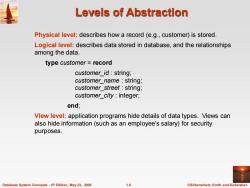
Levels of Abstraction Physical level:describes how a record(e.g.,customer)is stored. Logical level:describes data stored in database,and the relationships among the data. type customer record customer id:string; customer_name string; customer_street:string; customer_city:integer; end; View level:application programs hide details of data types.Views can also hide information(such as an employee's salary)for security purposes. Database System Concepts-5th Edition,May 23,2005 1.6 ©Silberschat乜,Korth and Sudarshan
Database System Concepts - 5 1.6 ©Silberschatz, Korth and Sudarshan th Edition, May 23, 2005 Levels of Abstraction Physical level: describes how a record (e.g., customer) is stored. Logical level: describes data stored in database, and the relationships among the data. type customer = record customer_id : string; customer_name : string; customer_street : string; customer_city : integer; end; View level: application programs hide details of data types. Views can also hide information (such as an employee’s salary) for security purposes
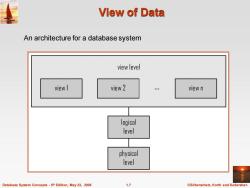
View of Data An architecture for a database system view level view 1 view 2 view n logical level physical level Database System Concepts-5th Edition,May 23,2005 1.7 ©Silberschat乜,Korth and Sudarshan
Database System Concepts - 5 1.7 ©Silberschatz, Korth and Sudarshan th Edition, May 23, 2005 View of Data An architecture for a database system
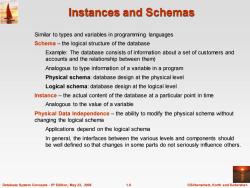
Instances and Schemas Similar to types and variables in programming languages Schema-the logical structure of the database Example:The database consists of information about a set of customers and accounts and the relationship between them) Analogous to type information of a variable in a program Physical schema:database design at the physical level Logical schema:database design at the logical level Instance-the actual content of the database at a particular point in time Analogous to the value of a variable Physical Data Independence-the ability to modify the physical schema without changing the logical schema Applications depend on the logical schema In general,the interfaces between the various levels and components should be well defined so that changes in some parts do not seriously influence others Database System Concepts-5th Edition,May 23,2005 1.8 ©Silberschat乜,Korth and Sudarshan
Database System Concepts - 5 1.8 ©Silberschatz, Korth and Sudarshan th Edition, May 23, 2005 Instances and Schemas Similar to types and variables in programming languages Schema – the logical structure of the database Example: The database consists of information about a set of customers and accounts and the relationship between them) Analogous to type information of a variable in a program Physical schema: database design at the physical level Logical schema: database design at the logical level Instance – the actual content of the database at a particular point in time Analogous to the value of a variable Physical Data Independence – the ability to modify the physical schema without changing the logical schema Applications depend on the logical schema In general, the interfaces between the various levels and components should be well defined so that changes in some parts do not seriously influence others
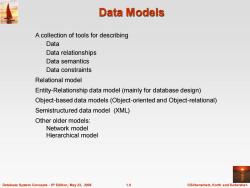
Data Models A collection of tools for describing Data Data relationships Data semantics Data constraints Relational model Entity-Relationship data model(mainly for database design) Object-based data models(Object-oriented and Object-relational) Semistructured data model (XML) Other older models: Network model Hierarchical model Database System Concepts-5th Edition,May 23,2005 1.9 @Silberschatz,Korth and Sudarshan
Database System Concepts - 5 1.9 ©Silberschatz, Korth and Sudarshan th Edition, May 23, 2005 Data Models A collection of tools for describing Data Data relationships Data semantics Data constraints Relational model Entity-Relationship data model (mainly for database design) Object-based data models (Object-oriented and Object-relational) Semistructured data model (XML) Other older models: Network model Hierarchical model
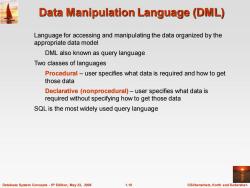
Data Manipulation Language (DML) Language for accessing and manipulating the data organized by the appropriate data model DML also known as query language Two classes of languages Procedural-user specifies what data is required and how to get those data Declarative (nonprocedural)-user specifies what data is required without specifying how to get those data SQL is the most widely used query language Database System Concepts-5th Edition,May 23,2005 1.10 @Silberschatz,Korth and Sudarshan
Database System Concepts - 5 1.10 ©Silberschatz, Korth and Sudarshan th Edition, May 23, 2005 Data Manipulation Language (DML) Language for accessing and manipulating the data organized by the appropriate data model DML also known as query language Two classes of languages Procedural – user specifies what data is required and how to get those data Declarative (nonprocedural) – user specifies what data is required without specifying how to get those data SQL is the most widely used query language

Data Definition Language(DDL) Specification notation for defining the database schema Example: create table account account-number char(10), balance integer) DDL compiler generates a set of tables stored in a data dictionary Data dictionary contains metadata(i.e.,data about data) Database schema Data storage and definition language Specifies the storage structure and access methods used Integrity constraints Domain constraints Referential integrity(references constraint in SQL) Assertions Authorization Database System Concepts-5th Edition,May 23,2005 1.11 ©Silberschat乜,Korth and Sudarshan
Database System Concepts - 5 1.11 ©Silberschatz, Korth and Sudarshan th Edition, May 23, 2005 Data Definition Language (DDL) Specification notation for defining the database schema Example: create table account ( account-number char(10), balance integer) DDL compiler generates a set of tables stored in a data dictionary Data dictionary contains metadata (i.e., data about data) Database schema Data storage and definition language Specifies the storage structure and access methods used Integrity constraints Domain constraints Referential integrity (references constraint in SQL) Assertions Authorization
按次数下载不扣除下载券;
注册用户24小时内重复下载只扣除一次;
顺序:VIP每日次数-->可用次数-->下载券;
- 《数据库系统概念 Database System Concepts》原书教学资源(第五版,附录,英文版)Appendix C Advanced Relational Database Design.ppt
- 《数据库系统概念 Database System Concepts》原书教学资源(第五版,附录,英文版)Chapter B Hierarchical Model.ppt
- 《数据库系统概念 Database System Concepts》原书教学资源(第五版,附录,英文版)Chapter A Network Model.ppt
- 《数据库系统概念 Database System Concepts》原书教学资源(第六版,附录,英文版)Hierarchical Model.pdf
- 《数据库系统概念 Database System Concepts》原书教学资源(第六版,附录,英文版)Network Model.pdf
- 《数据库系统概念 Database System Concepts》原书教学资源(第六版,附录,英文版)Other Relational Query Languages.pdf
- 《数据库系统概念 Database System Concepts》原书教学资源(第六版,附录,英文版)Advanced Relational Database Design.pdf
- 《数据库系统概念 Database System Concepts》原书教学资源(第六版,PPT课件讲稿,英文版)Chapter 9 Application Design and Development.ppt
- 《数据库系统概念 Database System Concepts》原书教学资源(第六版,PPT课件讲稿,英文版)Chapter 8 Relational Database Design.ppt
- 《数据库系统概念 Database System Concepts》原书教学资源(第六版,PPT课件讲稿,英文版)Chapter 7 Database Design - The Entity-Relationship Approach.ppt
- 《数据库系统概念 Database System Concepts》原书教学资源(第六版,PPT课件讲稿,英文版)Chapter 6 Formal Relational Query Languages.ppt
- 《数据库系统概念 Database System Concepts》原书教学资源(第六版,PPT课件讲稿,英文版)Chapter 5 Advanced SQL.ppt
- 《数据库系统概念 Database System Concepts》原书教学资源(第六版,PPT课件讲稿,英文版)Chapter 4 Intermediate SQL.ppt
- 《数据库系统概念 Database System Concepts》原书教学资源(第六版,PPT课件讲稿,英文版)Chapter 3 Introduction to SQL.ppt
- 《数据库系统概念 Database System Concepts》原书教学资源(第六版,PPT课件讲稿,英文版)Chapter 26 Advanced Transaction Processing.ppt
- 《数据库系统概念 Database System Concepts》原书教学资源(第六版,PPT课件讲稿,英文版)Chapter 25 Advanced Data Types and New Applications.ppt
- 《数据库系统概念 Database System Concepts》原书教学资源(第六版,PPT课件讲稿,英文版)Chapter 24 Advanced Application Development.ppt
- 《数据库系统概念 Database System Concepts》原书教学资源(第六版,PPT课件讲稿,英文版)Chapter 23 XML.ppt
- 《数据库系统概念 Database System Concepts》原书教学资源(第六版,PPT课件讲稿,英文版)Chapter 22 Object-Based Databases.ppt
- 《数据库系统概念 Database System Concepts》原书教学资源(第六版,PPT课件讲稿,英文版)Chapter 21 Information Retrieval.ppt
- 《数据库系统概念 Database System Concepts》原书教学资源(第五版,PPT课件讲稿,英文版)Chapter 10 XML.ppt
- 《数据库系统概念 Database System Concepts》原书教学资源(第五版,PPT课件讲稿,英文版)Chapter 11 Storage and File Structure.ppt
- 《数据库系统概念 Database System Concepts》原书教学资源(第五版,PPT课件讲稿,英文版)Chapter 12 Indexing and Hashing.ppt
- 《数据库系统概念 Database System Concepts》原书教学资源(第五版,PPT课件讲稿,英文版)Chapter 13 Query Processing.ppt
- 《数据库系统概念 Database System Concepts》原书教学资源(第五版,PPT课件讲稿,英文版)Chapter 14 Query Optimization.ppt
- 《数据库系统概念 Database System Concepts》原书教学资源(第五版,PPT课件讲稿,英文版)Chapter 15 Transactions.ppt
- 《数据库系统概念 Database System Concepts》原书教学资源(第五版,PPT课件讲稿,英文版)Chapter 16 Concurrency Control.ppt
- 《数据库系统概念 Database System Concepts》原书教学资源(第五版,PPT课件讲稿,英文版)Chapter 17 Recovery System.ppt
- 《数据库系统概念 Database System Concepts》原书教学资源(第五版,PPT课件讲稿,英文版)Chapter 18 Data Analysis and Mining.ppt
- 《数据库系统概念 Database System Concepts》原书教学资源(第五版,PPT课件讲稿,英文版)Chapter 19 Information Retrieval.ppt
- 《数据库系统概念 Database System Concepts》原书教学资源(第五版,PPT课件讲稿,英文版)Chapter 2 Relational Model.ppt
- 《数据库系统概念 Database System Concepts》原书教学资源(第五版,PPT课件讲稿,英文版)Chapter 20 Database System Architectures.ppt
- 《数据库系统概念 Database System Concepts》原书教学资源(第五版,PPT课件讲稿,英文版)Chapter 21 Parallel Databases.ppt
- 《数据库系统概念 Database System Concepts》原书教学资源(第五版,PPT课件讲稿,英文版)Chapter 22 Distributed Databases.ppt
- 《数据库系统概念 Database System Concepts》原书教学资源(第五版,PPT课件讲稿,英文版)Chapter 23 Advanced Application Development.ppt
- 《数据库系统概念 Database System Concepts》原书教学资源(第五版,PPT课件讲稿,英文版)Chapter 24 Advanced Data Types.ppt
- 《数据库系统概念 Database System Concepts》原书教学资源(第五版,PPT课件讲稿,英文版)Chapter Advanced Transaction Processing.ppt
- 《数据库系统概念 Database System Concepts》原书教学资源(第五版,PPT课件讲稿,英文版)Chapter 3 SQL.ppt
- 《数据库系统概念 Database System Concepts》原书教学资源(第五版,PPT课件讲稿,英文版)Chapter 4 Advanced SQL.ppt
- 《数据库系统概念 Database System Concepts》原书教学资源(第五版,PPT课件讲稿,英文版)Chapter 5 Other Relational Languages.ppt
